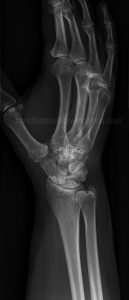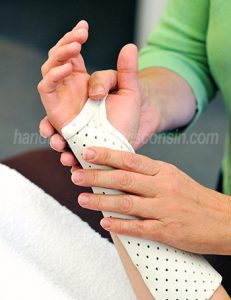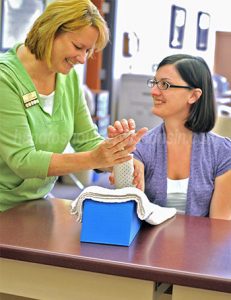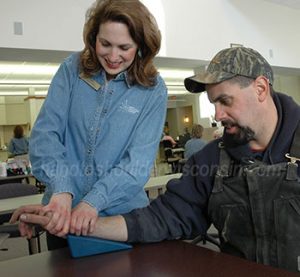At the Hand to Shoulder Center of Wisconsin, our orthopedic doctors have been specially trained to treat wrist fractures and other wrist injuries. From explaining the symptoms to diagnosing the fracture to performing both non-surgical and surgical treatment options, our team of dedicated orthopedic specialist can help. Contact us today for more information or with any questions.
What is a Wrist Fracture?
The wrist joint is made of up eight tiny bones known as the carpals and two larger forearm bones, the radius and ulna. The radius bone is located on the thumb side and the ulna bone is located on the little finger side of the forearm. The eight carpal bones (capitate, hamate, lunate, pisiform, scaphoid, trapezium, trapezoid, and triquetrum) are arranged in two rows, one on top of the other. The scaphoid and lunate bones are connected to the radius (Fig 1-3). The shape and construction of the carpal bones, radius, and ulna bones provides great flexibility at the wrist joint allowing twisting, bending, extending, and side to side movements. Wrist injuries commonly occur from falling on an outstretched hand, sports-related accident, or a forceful injury such as an auto accident. These injuries can lead to a break in one of the bones, known as a wrist fracture.
 Figure 1: X-rays capture the bones of the wrist |
 Figure 2: X-rays capture the bones of the wrist |
 Figure 3: X-rays capture the bones of the wrist |
What are Wrist Fracture Types and Symptoms
The wrist is a complex network of bones and joints. Fractured wrist symptoms include wrist pain, swelling, decreased mobility of the hand and wrist, and possible deformity of the wrist. Finger, hand, and arm stiffness are common symptoms of a wrist fracture. Fractures can be simple breaks or they can be unstable with bone fragments that displace or shift, causing the wrist to appear crooked. In other cases, the bone(s) may shatter causing the bone or bone fragments to break through the skin. This type of fracture is called an open (compound) fracture.
Wrist Fracture Treatment

Figure 4: Wrist splint application
At Hand to Shoulder Center of Wisconsin, our fellowship-trained orthopeadic surgeons evaluate past and present medical history. X-rays are taken and evaluated. Magnetic Resonance Imaging (MRI) or Computerized Tomography (CT) may be ordered if more detailed views of the fracture and fragments are needed to help determine the best treatment option. Surgical and non-surgical treatment varies widely depending on the location and severity of the injury, the pattern of the fracture or displacement, and the stability of the wrist.
Non-surgical treatment – in simple wrist fractures when the fractured bone remains aligned a splint or cast can be applied (Fig. 4-5). In some fractures when the bone is misaligned (displaced), the physician will provide a local or general anesthesia and gently position or “reduce” the fractured bone back into alignment. A cast is then applied to allow protection and stability to the injured bone(s).

Figure 5: Wrist splint application
Certain fractures require wrist fracture surgery to properly realign and fix the broken bones. Depending on the number of fractures, bone fragments, and the stability of the wrist bones, wires, plates, and screws may be used to fix the broken bone(s).
Surgery for a wrist fracture is generally performed as an outpatient procedure. The surgeons at Hand to Shoulder Center of Wisconsin perform surgeries at Woodland Surgery Center and the three Fox Valley hospitals. Following surgery, our physician may recommend hand therapy to help regain muscle strength and mobility (Fig. 6). Patients can expect soreness or discomfort at the injured site.

Figure 6: Wrist exercises are performed by a licensed therapist
Physical or occupational therapy may be started as early as a few days to weeks after surgery. Your therapist at Hand to Shoulder Center will concentrate on addressing post-operative swelling, improving range of motion, and rebuilding arm strength of the wrist and hand with therapy rehabilitation.